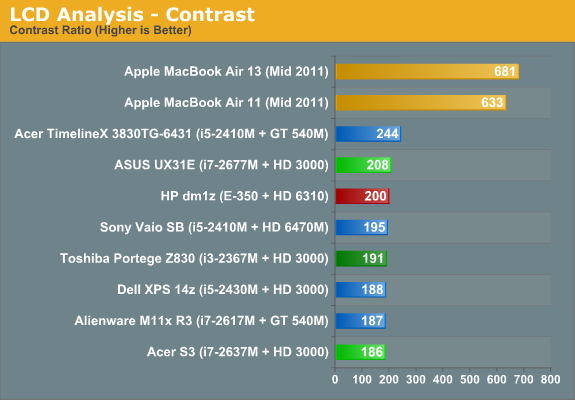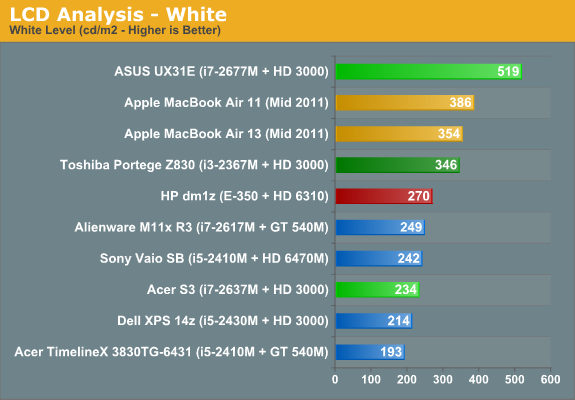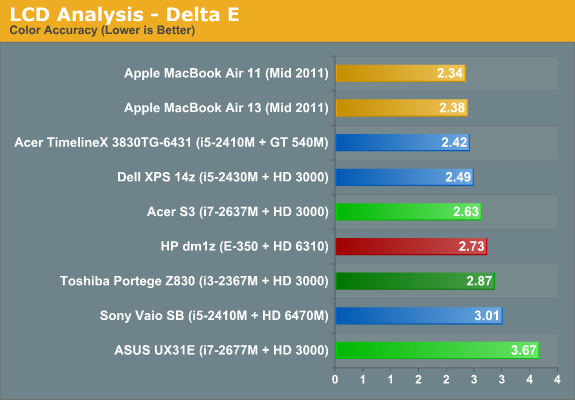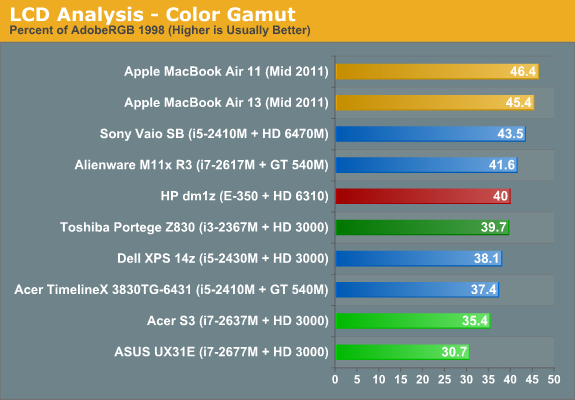Ultrabook Head to Head: Acer Aspire S3 vs. ASUS UX31E
by Jarred Walton & Manveer Wasson on December 21, 2011 5:40 AM ESTAnd Then We Get to the LCDs…
Sadly, as much as some areas of the laptops are improved over other offerings, the displays in general are nothing to get excited about. The Acer LCD is a bog standard model while the ASUS goes for a higher HD+ resolution and one of the brightest backlights we’ve tested on a laptop; unfortunately, contrast ratio along with color quality and gamut are all in the dumps. Let’s not dwell on it too much before we see the charts.





Of the laptops we’ve reviewed recently, the UX31E has the brightest LCD by far…along with the highest black level by far. The result is a contrast ratio that places near the top of our selection of eight mediocre displays. The Acer S3 on the other hand has middling white and black levels but the lowest contrast of the eight tested laptops. Continue on to color accuracy and gamut and things go from middling to lousy. The ASUS’ incredibly bright backlight results in very poor post-calibration Delta E of 3.67, with some colors in the double digits. Turn to the color gamut and we find part of the reason for that: the gamuts of both these ultrabooks are very poor, which means several of the test color patches are outside of their color range.
Viewing angles are typical of TN panels, with the vertical shots showing major color shifts. The ASUS panel does a lot better than the Acer, though neither one is great. We’ve got excellent 10.1” IPS panels now shipping in $400 tablets; why can’t we get a similar panel in 13.3” trim in a $1200 laptop? I’m probably preaching to the choir, but seriously: first IPS panel in a 13.3” laptop for under $1000 gets an Editor’s Choice award (as long as the rest of the laptop doesn’t completely suck).
In the grand scheme of things, though, how much do the LCD test results really matter? That’s a more difficult question to answer. Some users will never know what they’re missing, while others like to edit photos or watch movies and will immediately notice the poor contrast and colors. The color quality is a potential deal breaker for me, but if you’re just surfing the web and working in office applications, it really doesn’t make that much of a difference. For a go-anywhere laptop, the ASUS’ ultra bright LCD is definitely a plus—I took it outside and maxed out the backlight intensity and was still able to view the display contents without complaint, which is more than I can say for the laptops that max out at 200-250 nits.
When we look at the target the ultrabooks are trying to take down—Apple’s MacBook Air—the LCD results in particular are unacceptable. The MacBook Air displays are by no means perfect (I'd like a color gamut of at least 70% AdobeRGB for example), but notice how out of the tested laptops they place at the top in every test other than maximum brightness? That's what we'd like to see from the competition. ASUS at least made some effort to be different by going with a 1600x900 LCD with a high maximum backlight intensity, but Acer could have literally picked up any other 13.3” LCD and put in a similar showing. Take the price and OS out of the equation and the MacBook Airs are the superior “ultrabooks”, for two reasons: build quality and display quality. Acer improved their build quality over most of their budget offerings, and ASUS is right there with Apple in terms of build quality, but >500:1 contrast with >350 nits maximum brightness is the minimum I’d like to see, and really we’re talking about $1000+ laptops so it’s not too much to ask for an extra $50 to improve the displays.






















81 Comments
View All Comments
AssBall - Wednesday, December 21, 2011 - link
You know what would be cool? A 17" ultrabook. You could get a nice big screen and a keyboard that is not all clusterjammed in there. I hate tiny laptop keyboards.Nice review Jarred. I don't think I will be picking up one of these ultra's anytime soon. Looking forward to the Samsung review though.
Malih - Wednesday, December 21, 2011 - link
yes, I've been wondering why most thin laptops are limited to 13.3", would the extra space not be useful, or is it the limitation set by Intel, or is it because Apple don't make 15" MBA or is a 15" aluminum case cost too much to produce?17" might not be for everyone, but 14" or 15" are preferable for the masses, and with 15" you don't have to compete directly with Apple.
AssBall - Wednesday, December 21, 2011 - link
Maybe it is too expensive... I don't know. Plus the battery would be larger I suppose. It starts to get heavy and is no longer "ultra".I'd be very interested in a Llano based 17" Ultrabook with say a 128GB SSD, a more spread out keyboard, and a matte screen. Make the touch pad not suck too, please.
Thanks Santa.
cobalt42 - Wednesday, December 21, 2011 - link
Agree with both. If they used the extra keyboard space to make a nice cursor key cluster (arrow keys as well as home/end/pgup/pgdown and ins/del), they'd get my money. The others at that size either put a numeric keypad, or worse, nothing and just waste the extra space.AssBall - Wednesday, December 21, 2011 - link
Arrow keys and the home section, sometimes I wish they would toss it out because all of that stuff is on the number pad anyway. At least it is with my 12 year old WYSE keyboard. And then they could keep some space away from the standard qwerty section. I'd like that style of board. I don't much care for small function keys all crowded down either.Guspaz - Wednesday, December 21, 2011 - link
Strength becomes a bigger issue. If you keep the thickness the same, but increase the size to 17", the laptop would be enormously more delicate. More stress would be placed on it, if only because of the whole law-of-the-lever type thing. They'd have to make the 17" ultrabooks correspondingly thicker and more durable, and that would negate at least some of the advantage.A 15" ultrabook could be a lot more interesting, especially if they take advantage of a thinner bezel to fit the larger screen into a chassis that was only slightly larger than existing 13.3" ultrabooks.
Iketh - Wednesday, December 21, 2011 - link
nah I don't think durability would be hard to figure out, tho achieving that durability would likely increase the cost a good bitwadcock2 - Saturday, April 7, 2012 - link
ultrabook is define by Intel as a subnotebook with smaller size and weight. They are usually less than 6.5 lbs. They often have 7 -10 battery life (yea!). and are thin (< .7") to compete with Mac AirPro. There was one web page were the notebook had to fit into an 8.5"x11 interoffice mailing envelope. That also would require a smaller screen.I find that the 1366x768 pixel screens are too small to hole a whole video, photo or chart of today's web pages.
Yes, I'd like a light weight 17" laptop with long battery life and high screen resolution. The nearly 10 lbs plus another 2-4 for the power adapter makes it heavy to carry around and heavy on my lap.
bji - Wednesday, December 21, 2011 - link
Apple is supposed to be coming out with a 15 inch macbook air late Q1 next year. I am waiting for this and it will buy one; it will replace my 7 year old Panasonic Toughbook Y2 that thus far has not had a competitor for light weight, screen size, and build quality in the 14 inch+ size range.niva - Wednesday, December 21, 2011 - link
Right on, 17" frame will probably allow them to squeeze in a decent GPU in there too, something better than the integrated intel HD chip. Possibly even room for a hard drive to add more storage overall.The big thing I'm taking away from this review is the terrible screens. I'm surprised that they are that bad compared to the Apple screens. As much as many of us hate Apple and bash on them in the comments they've always been good about their displays.
Dell and Samsung are the companies who can buck this trend with terrible displays in these devices, lets hope it happens soon.